1993 PONTIAC BONNEVILLE steering wheel
[x] Cancel search: steering wheelPage 25 of 322
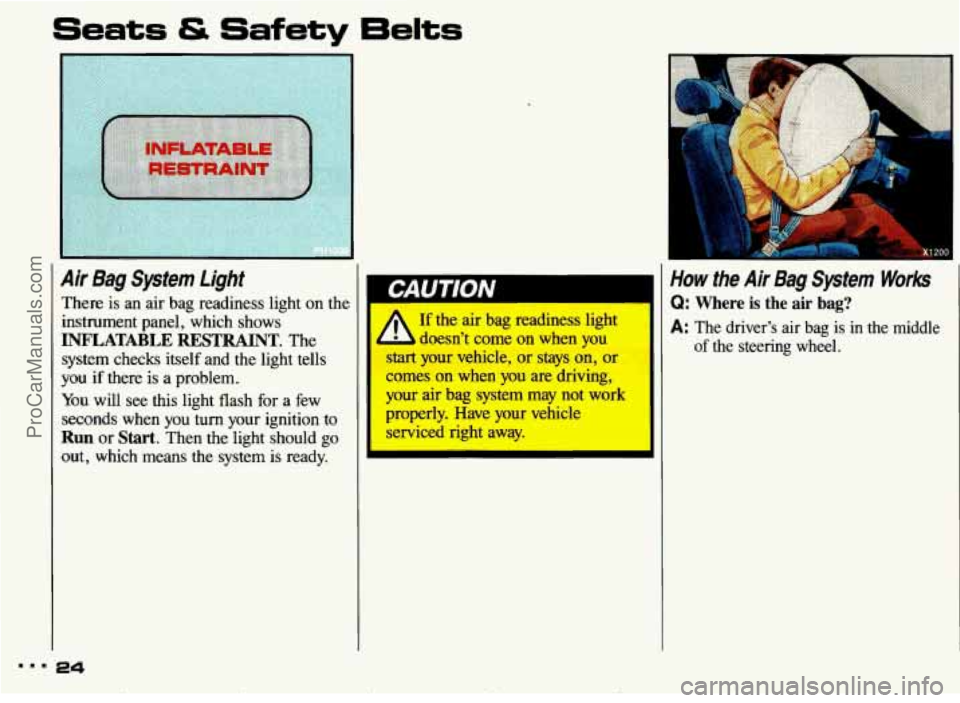
Seats & Safety 6elts
Air Bag System Light
There is an air bag readiness light on the
instrument panel, which shows
INFLATABLE RESTRAINT. The
system checks itself and the light tells
you if there is a problem.
You will see this light flash for a few
seconds when you turn your ignition to
Run or Start. Then the light should go
out, which means the system is ready.
If the air bag readiness light
L b doesn’t come on when you
s t your vehicle, or stays on, or
comes on when you are driving,
your air bag system may
not work
properly. Have your vehicle serviced right away.
4
3
How the Air Bag System Works
Q: Where is the air bag?
A: The driver’s air bag is in the middle
of the steering wheel.
ProCarManuals.com
Page 26 of 322
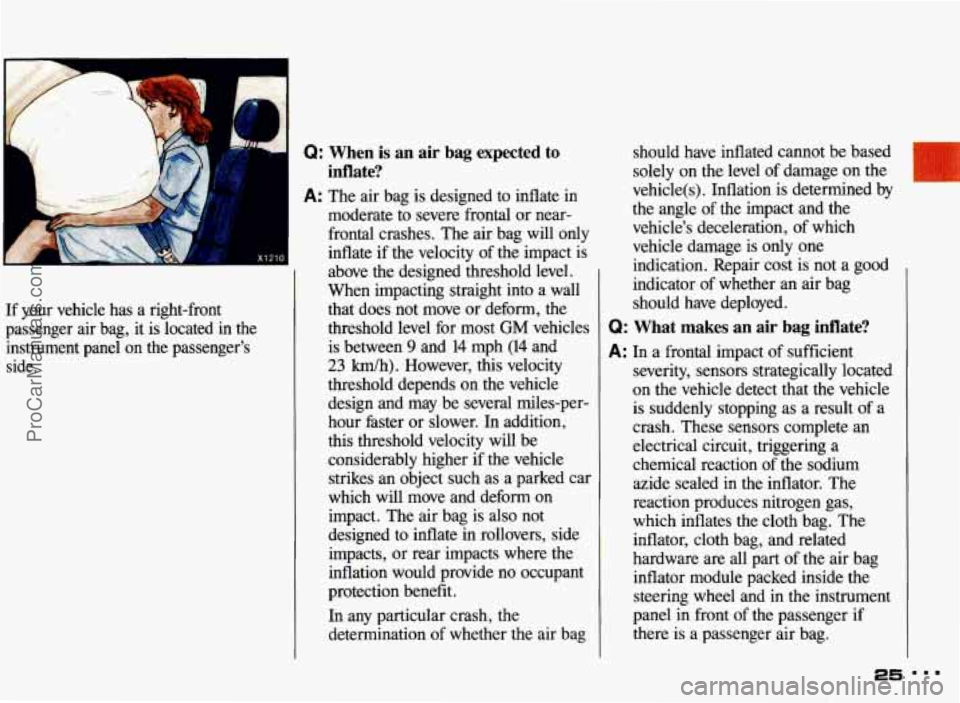
..
A
d Q: When is an air bag expected to
inflate?
A: The air bag is designed to inflate in
x1210 I
If your vehicle has a right-front
passenger air bag, it is located in the instrument panel on the passenger’s
side. moderate to severe
frontal or near-
frontal crashes. The air bag will only
inflate if the velocity
of the impact is
above the designed threshold level.
When impacting straight into a wall
that does not move or deform, the
threshold level for most
GM vehicles
is between
9 and 14 mph (14 and
23 km/h). However, this velocity
threshold depends on the vehicle
design and may be several miles-per-
hour faster or slower. In addition,
this threshold velocity will be
considerably higher
if the vehicle
strikes an object such as a parked car
which will move and deform on
impact. The air bag is also not
designed to inflate
in rollovers, side
impacts, or rear impacts where the
inflation would provide no occupant
protection benefit.
In any particular crash, the
determination of whether the air bag should
have inflated cannot be based
solely
on the level of damage on the
vehicle(s). Inflation is determined by
the angle of the impact and the
vehicle’s deceleration, of which
vehicle damage is
only one
indication. Repair cost is not a good
indicator of whether an air bag
should have deployed.
Q: What makes an air bag inflate?
A: In a frontal impact of sufficient
severity, sensors strategically located
on the vehicle detect that the vehicle
is suddenly stopping as
a result of a
crash. These sensors complete an
electrical circuit, triggering a
chemical reaction of the sodium
azide sealed in the inflator. The
reaction produces nitrogen gas,
which inflates the cloth bag. The
inflator, cloth bag, and related
hardware are all part of the air bag
inflator module packed inside the
steering wheel and in the instrument
panel in front of the passenger if
there is a passenger air bag.
26 DDD
ProCarManuals.com
Page 27 of 322
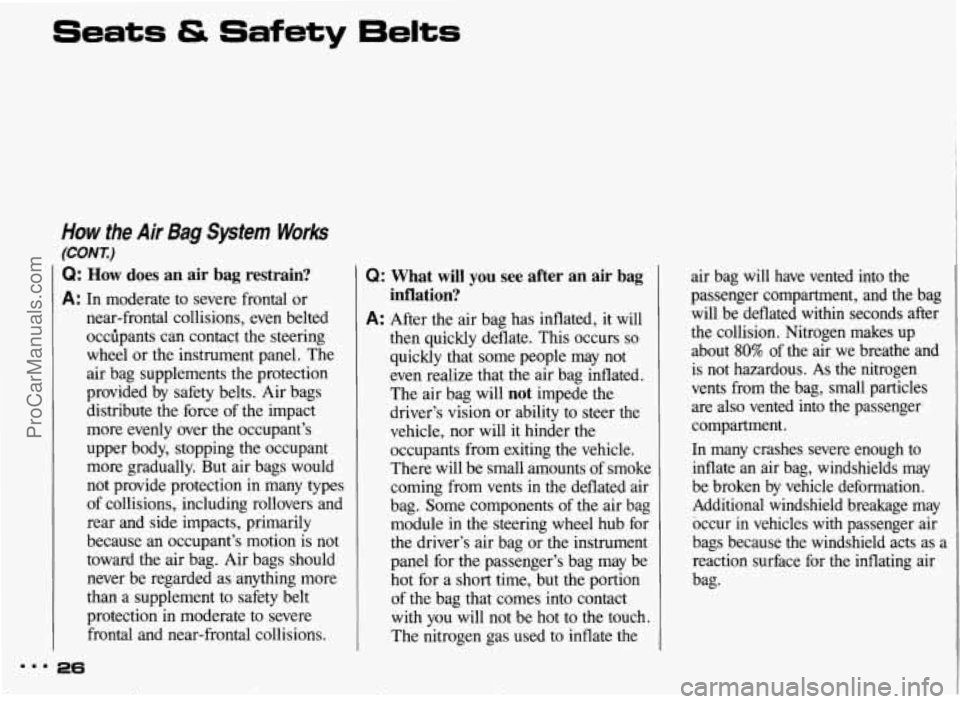
Seats & Safety Belts
How the Air Bag System Works
(CON X)
Q: How does an air bag restrain?
A: In moderate to severe frontal or
near-frontal collisions, even belted
occilpants can contact the steering
wheel or the instrument panel. The
air bag supplements the protection
provided by safety belts. Air bags
distribute the force
of the impact
more evenly over the occupant’s
upper body, stopping the occupant
more gradually. But air bags would
not provide protection
in many types
of collisions, including rollovers and
rear and side impacts, primarily
because an occupant’s motion is not
toward the air bag. Air bags should
never be regarded as anything more
than a supplement
to safety belt
protection in moderate to severe frontal and near-frontal collisions.
Q: What will you see after an air bag
inflation?
A: After the air bag has inflated, it will
then quickly deflate. This occurs
so
quickly that some people may not
even realize that the air bag inflated.
The air bag will
not impede the
driver’s vision or ability to steer the
vehicle, nor will it hinder the
occupants from exiting the vehicle.
There will be small amounts of smoke
coming from vents in the deflated air
bag. Some components of the air bag
module in the steering wheel hub for
the driver’s air bag or the instrument
panel for the passenger’s bag may be
hot for a short time, but the portion
of the bag that comes into contact
with
you will not be hot to the touch.
The nitrogen gas used to inflate the air
bag will have vented into the
passenger compartment, and
the bag
will be deflated within seconds after the collision. Nitrogen makes
up
about 80% of the air we breathe and
is not hazardous.
As the nitrogen
vents from the bag, small particles
are also vented into
the passenger
compartment.
In many crashes severe enough to
inflate an air bag, windshields may
be broken by vehicle deformation.
Additional windshield breakage may
occur in vehicles with passenger air
bags because the windshield acts as a
reaction surface for the inflating air
bag.
mm. 26
L ProCarManuals.com
Page 28 of 322
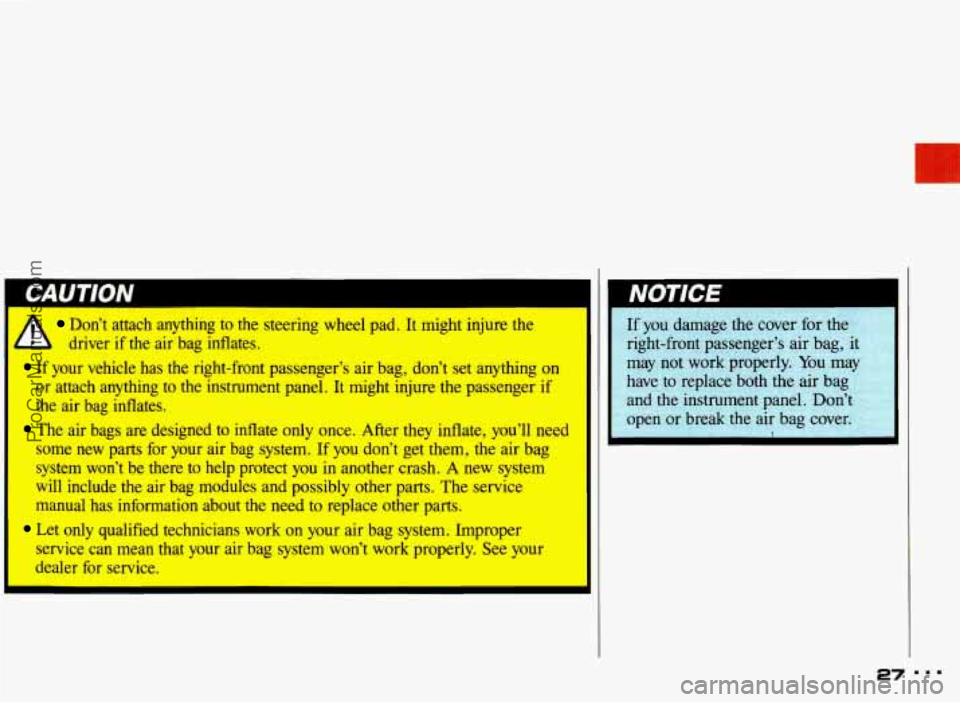
Don’t attach anything to the steering wheel pad. It might injure the
If your vehicle has the right-front passenger’s air bag, don’t set anything on
or attach anything to the instrument panel. It might injure the passenger if
the air bag inflates.
The air bags are designed to inflate only once. After they inflate, you’ll need
some new parts for your air bag system.
If you don’t get them, the air bag
system won’t be there
to help protect you in another crash. A new system
will include the air bag modules and possibly other parts. The service
manual has information about the need to replace other parts.
Let only qualified technicians work on your air bag system. Improper
service can mean that your air bag system won’t work properly.
See your
dealer
for service.
b driver if the air bag inflates.
If you damage the cover for the
right-front passenger’s air bag, it
may not work properly.
You may
have to replace both the air bag
and the instrument panel. Don’t
open or break the air bag cover.
7
27
ProCarManuals.com
Page 52 of 322
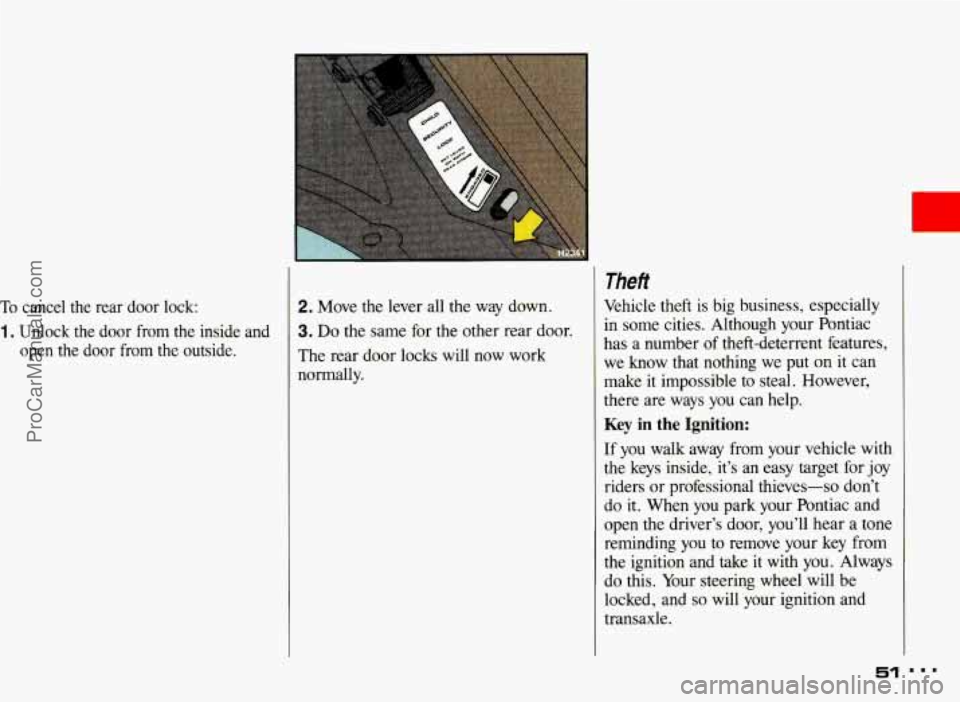
To cancel the rear door lock:
1. Unlock the door from the inside and
open the door from the outside.
2. Move the lever all the way down.
3. Do the same for the other rear door.
The rear door locks will now work
normally.
Theft
Vehicle theft is big business, especially
in some cities. Although your Pontiac
has a number
of theft-deterrent features,
we know that nothing we put
on it can
make it impossible to steal. However,
there are ways you can help.
Key in the Ignition:
If you walk away from your vehicle with
the keys inside, it’s an easy target for joy
riders or professional thieves-so don’t
do
it. When you park your Pontiac and
open the driver’s door, you’ll hear a tone
reminding you
to remove your key from
the ignition and take it with you. Always
do this. Your steering wheel will be
locked, and
so will your ignition and
transaxle.
51
ProCarManuals.com
Page 58 of 322
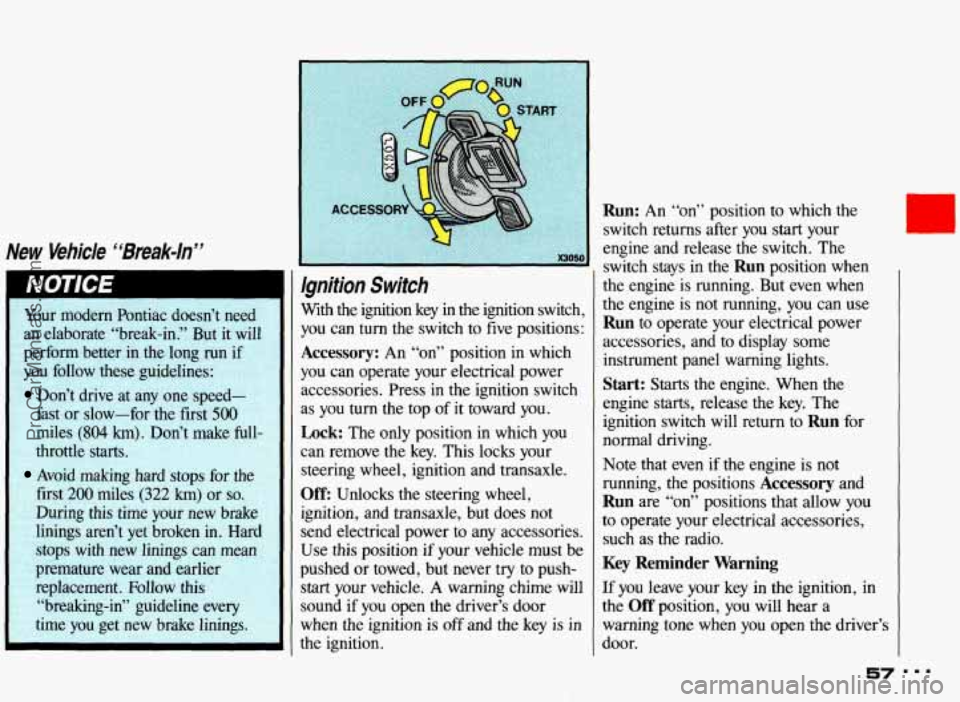
New Venice bbBreak-ln”
Your modern Pontiac doesn’t need
an elaborate “break-in.” But it will
perform better
in the long run if
you follow these guidelines:
Don’t drive at any one speed-
fast or slow-for the first
500
.miles (804 km). Don’t make full-
throttle
starts.
Avoid making hard stops for the
first 200 miles (322 km) or so.
During this time your new brake
linings aren’t yet broken in. Hard
stops
with new linings can mean
premature wear and earlier
replacement. Follow this “breaking-in” guideline every
time you get
new brake linings.
Ignition Switch
With the ignition key in the ignition switch,
you can turn the switch to five positions:
Accessory: An “on” position in which
you can operate your electrical power
accessories. Press in the ignition switch
as
you turn the top of it toward you.
Lock: The only position in which you
can remove the key. This locks your
steering wheel, ignition and transaxle.
Off: Unlocks the steering wheel,
ignition, and transaxle, but does not
send electrical power to any accessories.
Use this position if your vehicle must be
pushed or towed, but never try to push-
start your vehicle. A warning chime will
sound if you open the driver’s door
when the ignition is
off and the key is in
the ignition.
Run: An “on” position to which the
switch returns after you
start your
engine and release the switch. The
switch stays in the
Run position when
the engine is running. But even when
the engine is not running, you can use
Run to operate your electrical power
accessories, and to display some
instrument panel warning lights.
Start: Starts the engine. When the
engine starts, release the key. The
ignition switch will return to
Run for
normal driving.
Note that even if the engine
is not
running, the positions
Accessory and
Run are “on” positions that allow you
to operate your electrical accessories,
such as the radio.
Key Reminder Warning
If you leave your key in the ignition, in
the
Off position, you will hear a
warning tone when you open the driver’s
door.
57 ===
ProCarManuals.com
Page 73 of 322
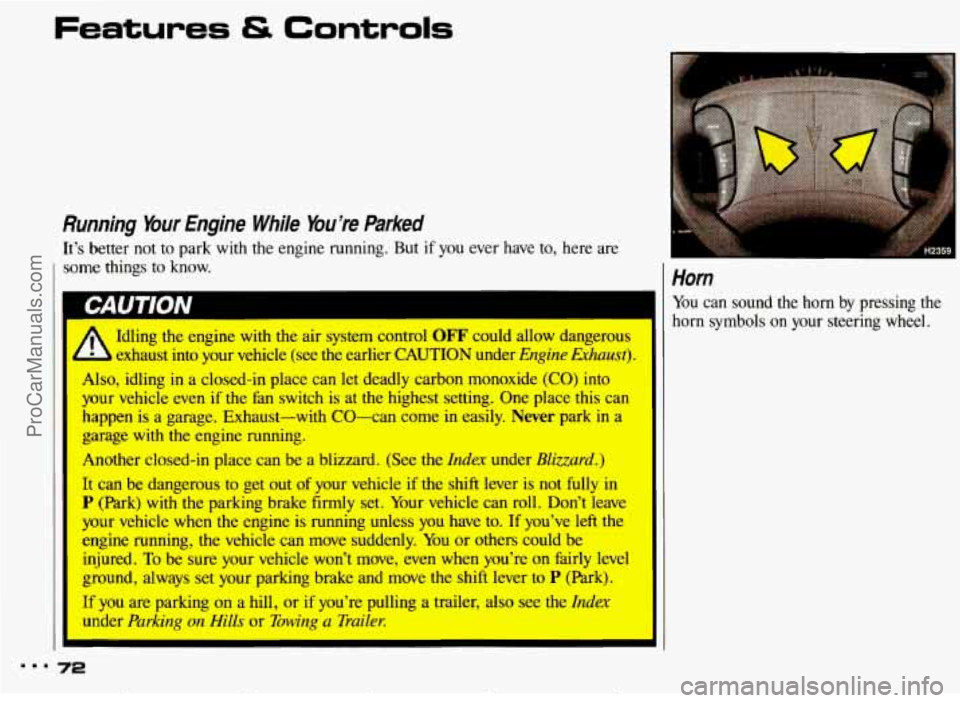
Features & Controls
Running Your Engine While You’re Parked
It’s better not to park with the engine running. But if you ever have to, here are
I some things to know.
II Idling the engine with the air system control OFF could allow dangerous
xhaust
into your vehicle (see the earlier CAUTION under Engine Exhaust). ‘
so, idling in a closed-in place can let deadly carbon monoxide (CO) into
your vehicle even
if the fan switch is at the highest setting. One place this can
happen is a garage. Exhaust-with CO-can come
in easily. Never park in a
garage
with the engine running.
Another closed-in place can be a blizzard. (See
the Index under Bliaard.)
It can be dangerous to get out of your vehicle if the shift lever is not fully in
P (Park) with the parking brake firmly set. Your vehicle can roll. Don’t leave
your vehicle when the engine is running unless you have to. If you’ve
left the
engine running, the vehicle can move suddenly. You or others could be
injured.
To be sure your vehicle won’t move, even when you’re on fairly level\
ground, always set your parking brake and move
the shift lever to P (Park).
If you are parking on a hill, or if you’re pulling a trailer, also see the Zndex
under Parking on Hills or Towing a Truik
rn.1 72
Horn
You can sound the horn by pressing the
horn
symbols on your steering wheel,
ProCarManuals.com
Page 74 of 322
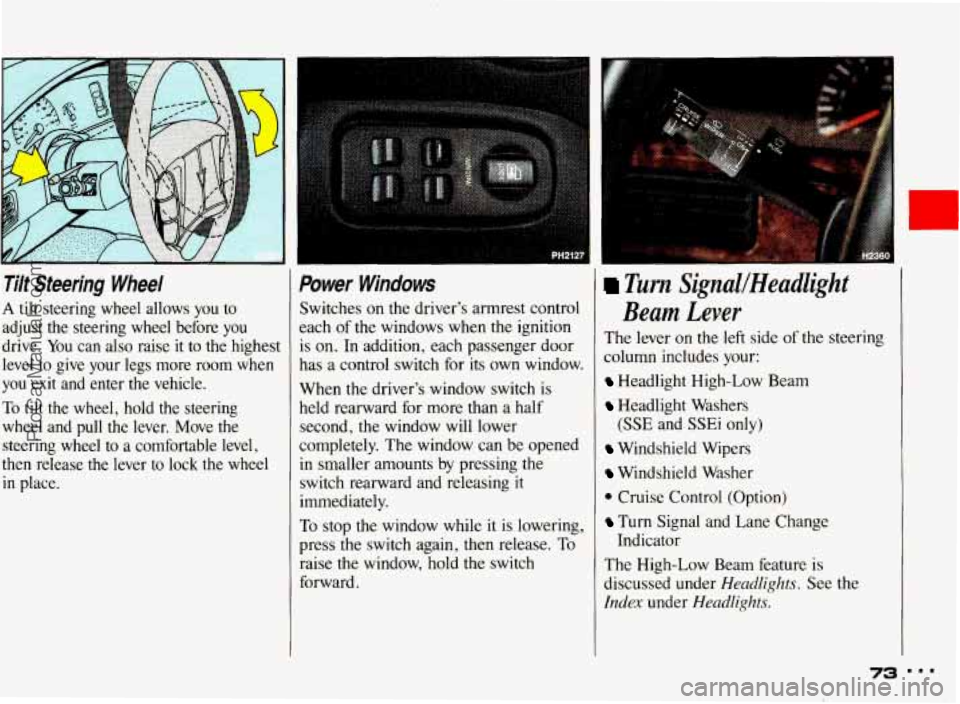
Tilt Steering Wheel
A tilt steering wheel allows you to
adjust the steering wheel before you
drive. You can
also raise it to the highest
level to give your legs more room when
you
exit and enter the vehicle.
To tilt the wheel, hold the steering
wheel and
pull the lever. Move the
steering wheel to a comfortable level,
then release the lever
to lock the wheel
in place.
Power Windows
Switches on the driver’s armrest control
each
of the windows when the ignition
is
on. In addition, each passenger door
has a control switch for its own window.
When the driver’s window switch is
held rearward for more than a half
second, the window will lower
completely. The window can be opened
in smaller amounts by pressing the
switch rearward and releasing it
immediately.
To stop the window while it is lowering,
press the switch again, then release.
To
raise the window, hold the switch
forward.
r
Turn SignallHeadlight
Beam Lever
The lever on the left side of the steering
column includes your:
Headlight High-Low Beam
Headlight Washers
Windshield Wipers
Windshield Washer
0 Cruise Control (Option)
Turn Signal and Lane Change
The High-Low Beam feature is
discussed under
Headlights. See the
Index under Headlights.
(SSE and SSEi only)
Indicator
73 ==.
t ProCarManuals.com